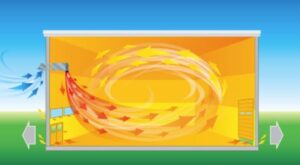In the midst of the last wave of summer heat, it is hard to imagine that there will ever be a need to turn on a heater to stay warm. However, due to the lead time to order, manufacture and install heating equipment, if you are planning to add new heaters or replace your aging heaters, now is the time to do so. Eldridge along with our partner, Cambridge Air Solutions, want to share a few tips for selecting heaters to ensure that you are making the right investment.
Targeting the Right Temperature
When it comes to determining the right indoor temperature to maintain during the winter, don’t skimp on the heat. Numerous studies have documented that worker productivity decreased when the temperature was too low. Our recommendation is to maintain a minimum indoor temperature of 50 degrees F, provided that workers can wear additional clothing for thermal comfort. Where manual dexterity is required or bulky clothing is a safety risk, the minimum temperature should be closer to 68 degrees F.
Destratification
It is a given that heat will rise. So the issue in tall buildings is how to keep the warm air close to the ground where most workers are present. The technical term for this is destratification. The best solution is to chose a heater that has a blower capable of moving the air in a pattern that will cause destratification.
The illustration below shows a representation of the destratification air flow pattern produced by the Cambridge HTHV heater technology. In a study of a building with 28 feet ceilings that was utilizing Cambridge heaters with HTHV technology, there was only a 2.5 degree F temperature differential between the temperature from floor to ceiling.

Heated Make-up Air
Buildings that have high bay doors that open frequently will need to provide heated make-up during the winter. Maintaining a slightly positive pressure in the building will prevent drafts of cold air from entering either through the open doors or from other unwanted entry points.
The other benefit of heated make-up air is better indoor air quality. Sealing buildings during the winter to prevent heat from escaping also tends to trap smoke, fumes and odors inside. The air quality problem can be compounded by recirculating systems that run these airborne contaminates through the heater units.
Return on Investment
Determining the return on investment (ROI) for a new heating system goes a long way towards justifying the investment. Factors such as productivity gain, reliability and maintenance have an impact on ROI. However, the biggest factor impacting ROI is energy efficiency. The Cambridge heaters with HTHV technology are some of the most efficient on the market. In comparative studies, they have been shown to be 20%-70% more energy efficient than all other types of indirect and direct gas-fired systems.
Conclusion
Imagine being able to provide a warmer, more productive environment for your workers this winter while saving money at the same time. That is what Cambridge can provide through its heaters with HTHV technology. Let us demonstrate how an investment in Cambridge heaters can create a successful environment for your facility this winter.
